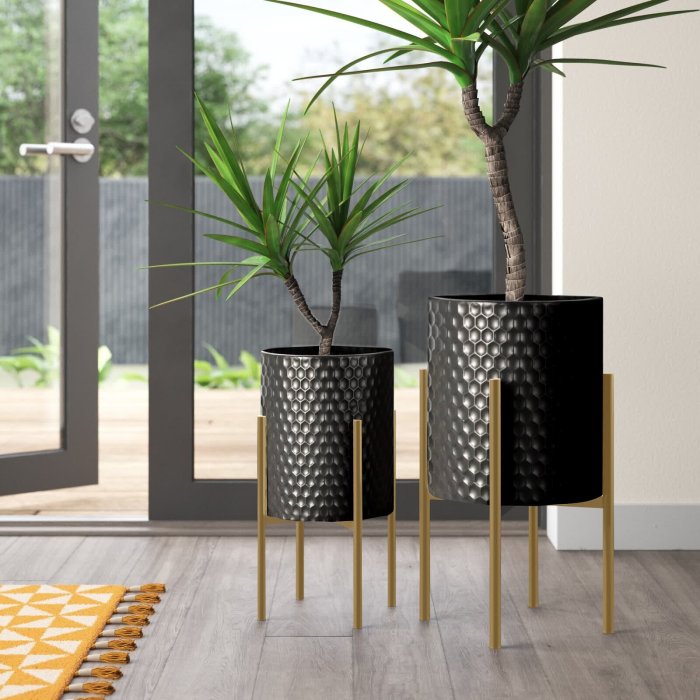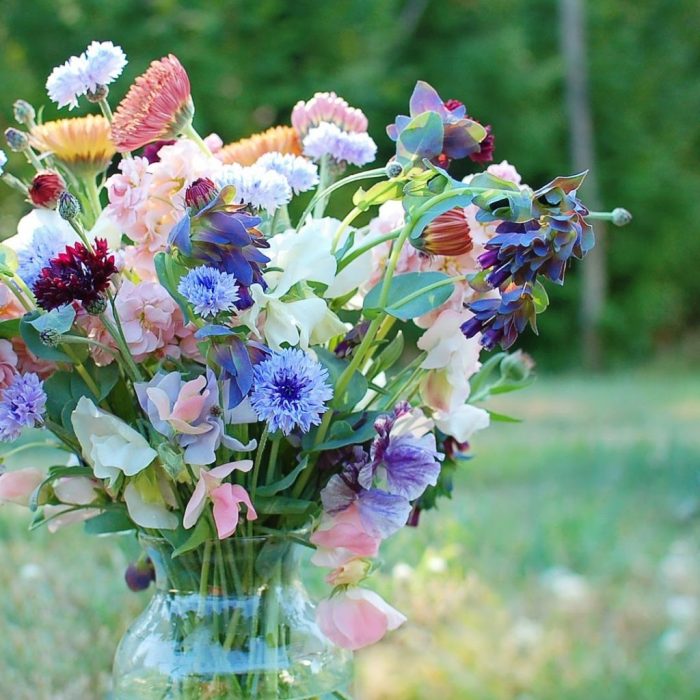Sizing and Selection of Large Tree Pots

Large plant pots for trees – Selecting appropriately sized containers for large trees is crucial for their health and longevity. An improperly sized pot can restrict root growth, leading to stunted development, nutrient deficiencies, and ultimately, tree decline. The correct pot size allows for sufficient root expansion, water retention, and overall tree vigor. This section will detail the factors influencing pot selection and provide guidance for determining the ideal pot size for various tree species.
Factors Influencing Pot Size Selection
Several factors must be considered when choosing a large tree pot. These include the tree’s species, its current size (particularly the root ball), its projected growth rate, and the intended planting location. The type of soil used in the pot also plays a significant role, as different soil mixes retain varying amounts of moisture. A well-draining soil mix may necessitate a slightly larger pot compared to a heavier, moisture-retentive mix to avoid waterlogging.
Finally, the pot material itself impacts the container’s ability to retain moisture and temperature, with some materials offering better insulation than others.
Determining Ideal Pot Volume
The ideal pot volume is directly related to the tree’s root system and its projected growth over a specific timeframe. A general guideline is to select a pot that is at least 1.5 to 2 times the diameter of the root ball. For example, if a tree has a root ball with a diameter of 30 centimeters, a pot with a diameter of at least 45 to 60 centimeters would be appropriate.
This allows for ample space for root expansion over the next few years before repotting becomes necessary. However, excessively large pots can lead to overwatering and poor drainage, so the size should be carefully considered. For faster-growing species, larger pots might be necessary, while slower-growing species might thrive in slightly smaller containers.
Measuring a Tree’s Root Ball for Pot Selection
Measuring a tree’s root ball accurately is vital for selecting the right pot size. First, carefully remove the tree from its existing container. Then, using a measuring tape, determine the diameter of the root ball at its widest point. Measure the height of the root ball as well. These measurements will help determine the minimum volume required for the new pot.
For example, a root ball with a diameter of 40cm and a height of 50cm requires a pot with a volume significantly larger than a root ball with a diameter of 20cm and a height of 30cm. Visual inspection of the root system will also help assess whether the roots are circling or tightly bound, which might indicate the need for a larger pot to prevent root restriction.
Recommended Minimum Pot Sizes for Selected Tree Species
The following list provides recommended minimum pot sizes for selected tree species. These are guidelines, and the actual size may need adjustment based on the specific tree’s size, growth rate, and overall health. Remember to always prioritize sufficient space for root development.
- Japanese Maple (Acer palmatum): Minimum pot diameter: 45cm (depending on cultivar and age)
- Crape Myrtle (Lagerstroemia indica): Minimum pot diameter: 50cm (depending on cultivar and age)
- Red Oak (Quercus rubra): Minimum pot diameter: 60cm (for young trees, larger pots needed for older trees)
- Birch (Betula spp.): Minimum pot diameter: 40-50cm (depending on species and age)
- Dogwood (Cornus spp.): Minimum pot diameter: 45cm (depending on species and age)
Drainage and Watering Considerations: Large Plant Pots For Trees
Proper drainage and watering are critical for the long-term health and survival of trees planted in large containers. Neglecting these aspects can lead to root rot, nutrient deficiencies, and ultimately, the death of the tree. Effective strategies for managing water and ensuring adequate drainage are essential for successful container tree cultivation.Effective drainage prevents waterlogging, a major cause of root rot.
Choosing the right large plant pots for trees is crucial for healthy growth. The size you select will depend greatly on the tree’s maturity; for smaller saplings, a more manageable size like a 10 gallon plant pot might suffice initially. However, as the tree develops, remember to upsize to accommodate its expanding root system, ensuring the pot provides ample space for robust growth in the long term.
Waterlogged roots are deprived of oxygen, leading to decay and the inability to absorb nutrients. Conversely, consistently dry soil stresses the tree, hindering its growth and making it vulnerable to pests and diseases. A balanced approach, ensuring adequate moisture while preventing waterlogging, is key.
Drainage Techniques for Large Tree Pots
Several techniques can be implemented to enhance drainage in large tree pots. The most fundamental is the selection of a pot with drainage holes in the base. These holes allow excess water to escape, preventing saturation of the root ball. The size and number of these holes are crucial; too few, and drainage will be insufficient; too many, and the potting mix may wash away too easily.
For extra drainage, a layer of gravel or broken pottery shards can be placed at the bottom of the pot before adding the potting mix. This layer acts as a reservoir for excess water, allowing for better drainage while also preventing the potting mix from clogging the drainage holes. Furthermore, the use of raised pot stands can further improve drainage by ensuring that the base of the pot is not sitting in standing water.
Soil Composition and Aeration
Proper soil composition is crucial for optimal tree health in containers. A well-aerated potting mix is essential for root respiration and nutrient uptake. Heavy clay soils retain too much water and lack sufficient aeration, whereas sandy soils drain too quickly, leading to frequent watering and potential nutrient leaching. An ideal potting mix is a balanced blend that retains moisture while allowing for adequate drainage and aeration.
This typically involves a mixture of components such as peat moss, perlite, vermiculite, and compost. The specific proportions will vary depending on the tree species and the climate. For instance, a mix heavier in peat moss might be suitable for moisture-loving trees in dry climates, whereas a mix with more perlite could be better for trees that prefer well-drained conditions.
Monitoring Soil Moisture Levels
Monitoring soil moisture is crucial to avoid both overwatering and underwatering. Several methods can be employed to assess soil moisture levels. A simple method involves inserting a finger into the soil; if the soil feels dry to a depth of about an inch, it’s time to water. More sophisticated methods include the use of moisture meters, which provide a numerical reading of soil moisture content.
These meters are inserted into the soil and provide an immediate indication of whether the soil is dry, moist, or wet. For large pots, it is advisable to take multiple readings at different points within the pot to obtain a representative measurement. Regular monitoring allows for timely adjustments to watering schedules, preventing both drought stress and root rot.
Creating a Well-Draining Potting Mix
Creating a well-draining potting mix involves carefully selecting and combining different components. A typical recipe might include:
One part peat moss (for moisture retention)One part perlite (for aeration and drainage)One part compost (for nutrients)
This basic recipe can be adjusted based on the specific needs of the tree species. For example, adding more perlite would improve drainage for a tree that is susceptible to root rot, while adding more compost would provide extra nutrients for a young, actively growing tree. The use of aged bark chips can also improve drainage and aeration.
It’s important to ensure the mix is thoroughly blended before planting to achieve uniform drainage and aeration throughout the pot. Testing the mix by watering it and observing the drainage rate can help to refine the recipe and ensure it meets the specific needs of the tree.
Cost and Sourcing of Large Plant Pots

The acquisition of large tree pots represents a significant investment in any landscaping or arboricultural project. Understanding the cost variations and sourcing options is crucial for effective budget planning and project success. Factors such as material, size, design features, and supplier influence the final price, demanding careful consideration before purchase.The price of large tree pots varies considerably depending on several key factors.
Material cost is a primary driver; durable, long-lasting materials like fiberglass or concrete naturally command higher prices than less robust plastic options. Size is another critical factor; larger pots require more material and labor, resulting in a steeper price increase. Specialized features, such as integrated drainage systems or aesthetically pleasing finishes, also add to the overall cost.
Finally, the supplier’s location, overhead, and profit margins influence the final price a buyer pays.
Material Costs and Price Comparison, Large plant pots for trees
Different materials yield different price points. For example, a large plastic pot might cost between $100 and $500, while a comparable fiberglass pot could range from $500 to $2000 or more, depending on size and features. Concrete pots, known for their durability, typically fall within a similar range to fiberglass, but can exceed $2000 for very large sizes. The cost per unit volume generally decreases with increasing size, though the absolute price increases significantly.
For instance, a 10-gallon plastic pot might cost $20, while a 500-gallon concrete pot might cost upwards of $1500.
Supplier Selection and Pricing Strategies
Choosing the right supplier is vital for securing the best price and ensuring quality. Some suppliers specialize in large-scale projects and offer bulk discounts, while others focus on individual sales and may have higher per-unit prices. It’s advisable to obtain quotes from multiple suppliers, comparing not only price but also delivery times, warranty provisions, and customer service reputation.
Negotiating bulk purchases can often lead to substantial savings. Additionally, understanding a supplier’s pricing structure – whether it’s based on volume, material, or a combination of factors – helps to make informed decisions.
Reputable Suppliers of Large Tree Pots
Finding reliable suppliers is paramount to avoid inferior quality or delayed delivery. A thorough research process involving online reviews and industry recommendations is crucial.
- Local landscape supply companies: Often offer a range of options and can provide personalized advice.
- Online retailers specializing in landscaping supplies: Provide a wider selection and potentially competitive pricing.
- Manufacturers of large containers: Can offer customized solutions and potentially better pricing on bulk orders.
- Nurseries specializing in larger trees: Frequently have established relationships with pot suppliers and may offer bundled pricing.
Q&A
How often should I water trees in large pots?
Watering frequency depends on factors like weather, pot material, and soil type. Check soil moisture regularly; water thoroughly when the top inch feels dry.
Can I use any type of soil for large tree pots?
No, use a well-draining potting mix designed for container plants. Avoid garden soil, which can compact and hinder drainage.
How do I prevent root-bound trees in large pots?
Repot your trees every few years into larger pots as they grow, ensuring ample space for root development. Regular pruning can also help manage size.
What are the best locations for large tree pots?
Consider sunlight needs, wind protection, and ease of watering. Avoid placing pots in areas prone to flooding or extreme temperature fluctuations.


